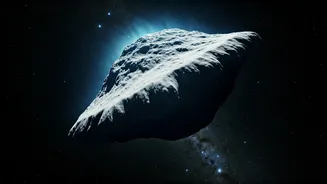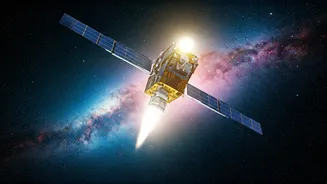What is 3I/ATLAS?
3I/ATLAS, an interstellar object, has recently been the subject of much discussion and intrigue. The emergence of a new photo allegedly leaked from NASA
has sparked further speculation. This photograph purportedly depicts an object with a spacecraft-like form, partially shrouded in dust. This has led to intense speculation about its nature, origin, and significance. The object has garnered interest and attention in various circles, including the scientific community and amateur astronomers. The term "3I/ATLAS" seems to be associated with this object, though specific details about its complete identity remain a subject of investigation. The leaked images and related discussions have added to the overall mystery surrounding the object. Further details from the image remain under investigation, and ongoing observation efforts are critical to uncovering its true nature.
Why 3I/ATLAS Matters?
The importance of 3I/ATLAS lies in the insights it may offer about interstellar objects, and the composition of space. Interstellar objects like 3I/ATLAS can provide scientists with valuable data regarding the diversity of cosmic objects and the potential for materials from elsewhere in the universe reaching our solar system. The ongoing scientific observations can help broaden our comprehension of the solar system and how it interacts with the interstellar environment. Because of this, any new discoveries have the potential to rewrite fundamental understandings of how space operates. Also, observations related to 3I/ATLAS might lead to novel discoveries in fields such as astrophysics, material science, and possibly even the search for life beyond Earth. Therefore, the ongoing study of the object is essential to furthering the knowledge of the universe, and it is a fascinating case of exploration and research.
Observation Efforts Underway
Intense scientific observation efforts are focused on the celestial object 3I/ATLAS, aiming to gather detailed data and better understand the object's characteristics. These efforts include the usage of cutting-edge telescopes and advanced imaging methods to capture information on its orbit, composition, and physical properties. Astronomers and researchers are actively analyzing any data they receive to gather information regarding the object's behavior and qualities, including the recent attention brought on by the alleged leaked NASA images. The aim of these efforts is to develop a thorough understanding of the object, which can help reveal the nature of the interstellar object and how it might affect our understanding of space. Moreover, these observation efforts are contributing to the broader field of space exploration, creating advancements in technology and scientific know-how. The ongoing attempts to investigate 3I/ATLAS show a commitment to advancing the boundaries of human knowledge and uncovering the cosmos' mysteries.
Following 3I/ATLAS’ Journey
Tracking the trajectory of 3I/ATLAS is a critical step in understanding its behavior, and origins. Space exploration organizations and astronomers use advanced techniques to trace the celestial object's trajectory. These methods include precise measurements of the object's position, velocity, and orbital path, which help to predict its future movements. The process of following its journey is complex, but it can provide insights into 3I/ATLAS’ origins, and the environment it has traveled through. Information about its past trajectory also helps to understand the object's interaction with the solar system. By tracking the journey of 3I/ATLAS, scientists can gain valuable information about the distribution of objects in space. Further, the ongoing monitoring efforts are necessary to protect space infrastructure from possible interactions with objects like 3I/ATLAS. Therefore, tracking the path of 3I/ATLAS is important for expanding our understanding of the cosmos, and ensuring safety in space.
When and Where to See?
To observe 3I/ATLAS, precise timing, and location are essential. The best viewing opportunities depend on the object's position in the sky, and its visibility from Earth. This requires understanding the object's orbit and making predictions about when it will be in a favorable position for observation. The ability to watch 3I/ATLAS depends on factors such as light pollution, weather conditions, and the observer's location. Those interested can follow updates from space agencies, astronomy organizations, and online platforms. These resources offer up-to-date data, and will notify the public about the best times to see it. Those who hope to observe 3I/ATLAS should know the locations of celestial objects and constellations. Careful planning and knowledge about the skies are necessary to enjoy the amazing phenomenon of observing 3I/ATLAS.














